

EDUCATION System in Pakistan
Aug 03, 2012
2.73k likes | 8.43k Views
EDUCATION System in Pakistan. 1. Constitution of Pakistan. 2. Constitution of the Islamic Republic of Pakistan, 1973 – Article 37-b. “ The State shall remove illiteracy and provide free and compulsory secondary education within minimum possible period”. Concurrent Legislative List:
Share Presentation
- no toilet no building
- efa global monitoring report
- domestic provision
- smaller towns
- concurrent legislative list
- poor monitoring
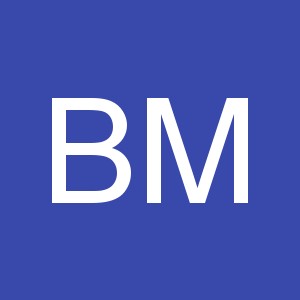
Presentation Transcript
EDUCATION System in Pakistan 1
Constitution of Pakistan 2
Constitution of the Islamic Republic of Pakistan, 1973 – Article 37-b “The State shall remove illiteracy and provide free and compulsory secondary education within minimum possible period” Concurrent Legislative List: Curriculum, syllabus, planning, policy, centres of excellence, standard of education & Islamic education 3
Millennium Development Goals (2001) 1. Ensuring that by 2015 all children, particularly girls, children in difficult circumstances and those belonging to ethnic minorities, have access to and complete free and compulsory primary education of good quality 2. Eliminating gender disparities in primary and secondary education by 2005, and achieving gender equality in education by 2015, with a focus on ensuring girls’ full and equal access to and achievement in basic education of good quality 4
EDUCATION SCENARIO 5
67% 28% 67% 48% 58% 22% 67% 42% Literacy Rates 47% Pakistan: 55% Male: 67% Female: 42% 58% Literacy Definition (As in 1998 Census) 42% “The ability of a person who can read a newspaper and write a simple letter in any language” 55% 6 Sources: Pakistan Social and Living Standard Measurement (PSLM) Survey 2006-07
Educational Institutions by Level 7 Source: National Education Census 2006, GoP
Institutions by Medium of Instruction 8 Source: National Education Census 2006, GoP
81,633 (50%) 57,216 (35%) 53,481 (33%) 46,766 (29%) 9,776 (6%) No Boundary Wall No Drinking Water No Electricity No Toilet No Building Total schools upto Middle level 160,798 PAKISTAN Missing Facilities 9 Source: National Education Census (NEC), 2006
EDUCATION BUDGET AS % AGE OF GDP (2005-06): SOUTH ASIA Source: EFA Global Monitoring Report 2008 10
Education Policy 11
Challenges • Weakened Governance • Fragmentation • Lack of Clarity in Inter-Tier Relationships • Poor Quality of Teachers & Managers • Quality of curriculum, textbooks & exams • Low level of literacy • Out of school children • Dropouts • Public Private Partnership • In-adequate financing • Gender Equity • Poor monitoring & evaluation • Imbalance in primary, middle & secondary schools • Inconvenient school location 12
Public/ Govt Schools • There is a huge difference amongst public schools in cities, small towns and villages • Some of the public schools in big cities are well resourced . At the same time in smaller towns and village areas some schools might not have basic facilities like desks, books, blackboards, electricity, doors, windows, toilets, drinking water, playgrounds, 60 per cent have no boundary walls and 16 percent are without a building.
Public/ Govt Schools • Some of the major problems public schools face include • limited financial resources • poor quality of content and a greater demand for education amongst parents of school-aged children. • overcrowded and/or underfunded. These issues have largely fuelled the revival of private schools in Pakistan.
Private schools • There is a huge variety of private schools in Pakistan • Not all private schools are elite, some cater for middle class and some for the poorest of the population as well • Private schools have an advantage to add things to the curriculum ( things for students grooming that is not for assessment) • Even the best private/ public schools teach 80% theory and 20 %activity based learning
In most schools teaching is for assessments so how much the child has learned is not what is the main concern Most schools promote rote learning Most schools teach obsolete concepts and methods of teaching that are not effective. There are only a handful of schools private and public where students are given good education
Student to teacher ratio in average private schools 30:1, state schools 50:1
Students from PK studying abroad
According to UNESCO (2008) Over that period there was a significant growth of two thirds from around 12,000 in 1999 to 21,000 in 2005. These changes have been produced by a number of factors. • The domestic provision of places by Pakistani universities is well below the demand • There is also a shortage of applied master’s courses in the country. • An increasing proportion of the population is becoming more affluent, both within the country and among those living abroad, and they require access to overseas education for their children • There is pressure on students to obtain applied mater’s degree if they aim for employment in an increasingly competitive job market.(skill shortage summary here)
Some pictures
Campaign against use of plastic bags
- More by User
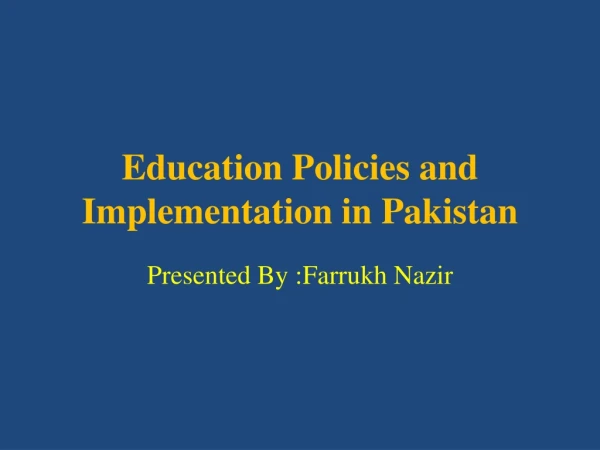
Education Policies and Implementation in Pakistan
Education Policies and Implementation in Pakistan. Presented By :Farrukh Nazir. Education policy.
2.28k views • 52 slides

Challenges in the Education Sector in Pakistan
Challenges in the Education Sector in Pakistan. Government of Pakistan Ministry of Education http://www.moe.gov.pk. Challenges in Education System. Challenge # 1: Low level of Literacy
503 views • 17 slides
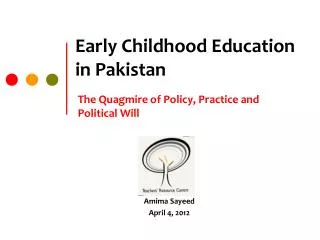
Early Childhood Education in Pakistan
Early Childhood Education in Pakistan. The Quagmire of Policy, Practice and Political Will. Amima Sayeed April 4, 2012. Policies and Provisions: What’s Been Achieved?. National Curriculum aligned with the developmental domains Contextualized, consultative and research based
2.28k views • 10 slides
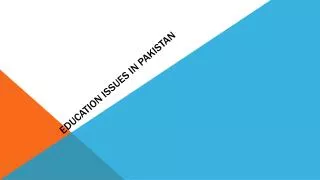
Education issues in Pakistan
Education issues in Pakistan. Uneducated in Pakistan. One out of ten primary school children that are uneducated is located in Pakistan. Pakistan is ranked second in global ranking of out-of-school children. 19.6 million children of primary school age, 6.8 million are not in primary school.
808 views • 9 slides
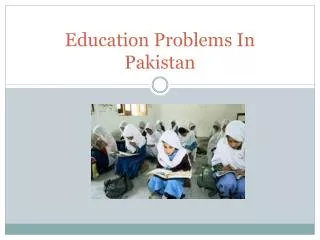
Education Problems In Pakistan
Education Problems In Pakistan. Introduction. Around the world, there are many countries that deny education to certain groups of people because of certain believes and mind sets on what they should not do.
3.69k views • 9 slides
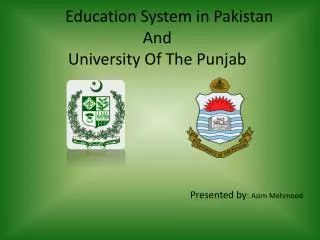
Education System in Pakistan And University Of The Punjab
Education System in Pakistan And University Of The Punjab. Presented by : Asim Mehmood. Pakistan. Education In Pakistan . I n Pakistan education is overseen by Ministry of Education of Government of Pakistan. The academic institutions are the responsibility of provisional government .
514 views • 23 slides
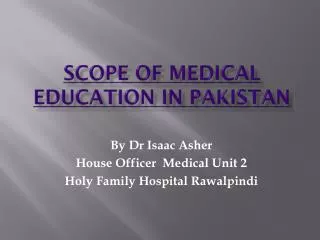
SCOPE OF MEDICAL EDUCATION IN PAKISTAN
SCOPE OF MEDICAL EDUCATION IN PAKISTAN. By Dr Isaac Asher House Officer Medical Unit 2 Holy Family Hospital Rawalpindi. Medicine . The word medicine is derived from the Latin ars medicina , meaning the art of healing
908 views • 12 slides
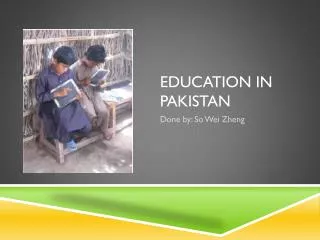
Education in pakistan
Education in pakistan. Done by: So Wei Zheng. deprivation of education (statistics). 51% of Pakistanis are deprived of basic education and health. Between 2000-2004, literacy rates in ages 55-64 was 38%. 45-54 was 46%, 25-34 was 54%, and 15-24 was nearly 57%.
478 views • 10 slides

GHAZALI EDUCATION TRUST PAKISTAN
Education Relief for NWFP IDPs. GHAZALI EDUCATION TRUST PAKISTAN. Summary. As military operation continues in Swat, Dir, Buner and adjacent locations, the residents of these areas are migrating to safer regions like Mardan, Charsadda and Peshawar.
302 views • 15 slides

EDUCATION System in Pakistan. 5 December , 2008. 1. Contents. PART - I Constitution of Pakistan Organization & Functions PART – II Education Scenario Financing Education Policy Other Programmes. 2. Constitution of Pakistan. 3.
2.69k views • 52 slides

UNIVERSAL PRIMARY EDUCATION IN PAKISTAN
UNIVERSAL PRIMARY EDUCATION IN PAKISTAN. AZHAR IQBAL KHAN M.Phil Student Iqra University , 01 December , 2013. 2. Constitution of Pakistan. 3. Constitution of the Islamic Republic of Pakistan, 1973 – Article 37-b.
2.23k views • 33 slides

Education System in Pakistan And University Of The Punjab. Presented by : Asim Mehmood. Pakistan. Education In Pakistan. I n Pakistan education is overseen by Ministry of Education of Government of Pakistan. The academic institutions are the responsibility of provisional government .
666 views • 23 slides
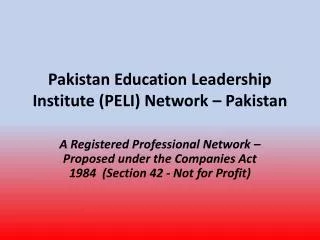
Pakistan Education Leadership Institute (PELI) Network – Pakistan
Pakistan Education Leadership Institute (PELI) Network – Pakistan. A Registered Professional Network – Proposed under the Companies Act 1984 (Section 42 - Not for Profit). Vision. Building Communities of Best Practice for Quality Professional Learning & Leadership across Pakistan and AJK.
451 views • 23 slides
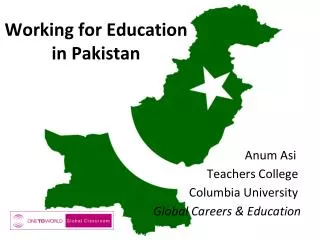
Working for Education in Pakistan
Working for Education in Pakistan. Anum Asi Teachers College Columbia University Global Careers & Education. Wh at continent is my country on?. Enlarge the map of your continent. Karachi.
454 views • 25 slides
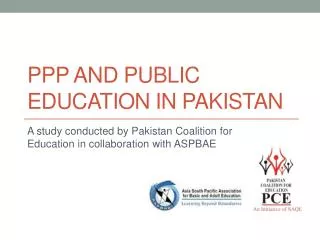
PPP and Public Education in Pakistan
PPP and Public Education in Pakistan. A study conducted by Pakistan Coalition for Education in collaboration with ASPBAE. Introduction. The research is conducted by PCE with the support of in ASPBAE and OSF highlights the Public Private Partnerships (PPP) in Pakistan.
693 views • 23 slides

PAKISTAN ADMINISTRATIVE SYSTEM
PAKISTAN ADMINISTRATIVE SYSTEM. COMPARATIVE PUBLIC ADMINISTRATION MPA 503 LECTURE 29. MANAGEMENT IN PAKISTAN. PAKISTAN IS A FEDERAL STATE.
542 views • 25 slides

Food System in Pakistan
Food System in Pakistan. Nazim Ali. Nazim Ali. Global Change Impact Studies Centre Islamabad, Pakistan. Irrigated Landscape of District Gujrat. Wheat Production in Districts of Punjab Pakistan. Gujrat. (SDPI, 2004). Rice Production in Districts of Punjab Pakistan. Gujrat. (SDPI, 2004).
1.15k views • 26 slides
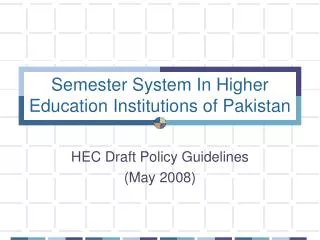
Semester System In Higher Education Institutions of Pakistan
Semester System In Higher Education Institutions of Pakistan. HEC Draft Policy Guidelines (May 2008). Background. Deliberated on two systems (Annual and Semester) Different forms of semester (Bisemester, Trisemester, and term system) in HEI
1.13k views • 31 slides
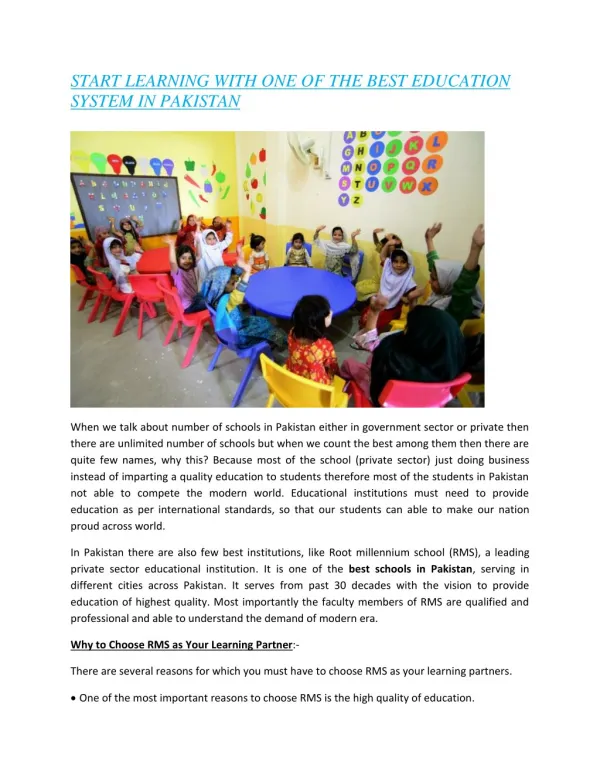
START LEARNING WITH ONE OF THE BEST EDUCATION SYSTEM IN PAKISTAN
When we talk about number of schools in Pakistan either in government sector or private then there are unlimited number of schools but when we count the best among them then there are quite few names, why this? Because most of the school (private sector) just doing business instead of imparting a quality education to students therefore most of the students in Pakistan not able to compete the modern world. Educational institutions must need to provide education as per international standards, so that our students can able to make our nation proud across world.
29 views • 2 slides
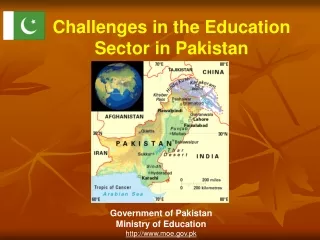
300 views • 17 slides

243 views • 23 slides

The Innovation In Banking System In Pakistan
The banking system of Pakistan has come a long way from how it was just a decade ago. With strong emphasis on digitizing the many banking facilities, the aim is to fulfill the needs of todayu2019s generation who prefers things on-the-go as compared to the conventional banking system that involved waiting in long lines to pay utility bills, deposit cash, clear a query, etc.
101 views • 8 slides

Handbook of Education Systems in South Asia pp 1–30 Cite as
School Education System in Pakistan
Expansion, Access, and Equity
- Anjum Halai 3 &
- Naureen Durrani 4
- Living reference work entry
- First Online: 31 July 2020
677 Accesses
2 Citations
1 Altmetric
Part of the book series: Global Education Systems ((GES))
In Pakistan, all children between 5 and 16 years of age have the right to 12 years of school education. The public school system is the main provider of schooling. Pakistan takes explicit account of gender in the provision of schooling, especially in public schools at post-primary levels, with girls’ schools with female teachers and boys’ schools with male teachers.
While the policy context has always been supportive of universal school education, there is a significant gap in access, especially for girls at post-primary levels. The private sector has an increasingly large share in education with strong public–private partnership models to enhance access to quality education for the needy. Mostly, the medium of instruction is Urdu in public schools and English in private schools.
This chapter describes the school education system in Pakistan and provides insights into issues of access, expansion, and equity in the specific sociocultural and language context of the country.
- School education
- Universal education
- Public–private schooling
- Language of instruction
- Gender and schooling
This is a preview of subscription content, log in via an institution .
AEPAM. (2013). Pakistan Education Statistics 2012–13. Academy of Education Planning and Management (AEPAM) . Islamabad: Ministry of Professional and Technical Training Government of Pakistan. Retrieved from http://library.aepam.edu.pk/ .
Ahmad, V., & Zeeshan, M. (2014). An analysis of the social impact of the stipend program for secondary school girls of Khyber Pakhtunkhwa. Educational Research for Policy and Practice, 13 , 129–143.
Article Google Scholar
Ahmed, S. A. Cho, Y., & Fasih, T. (2019). Pakistan@100 human capital. Policy note. World Bank Group. Retrieved April 9, 2020, from http://documents.worldbank.org/curated/en/181471552638661744/pdf/135324-14-3-2019-20-35-15-PakPNHumanCapitalLaunchFinal.pdf
Aly, J. (2007). Education in Pakistan: A white paper: Revised: Document to debate and finalize the national education policy. Retrieved December 19, 2018, from http://planipolis.iiep.unesco.org/sites/planipolis/files/ressources/pakistan_national_education_policy_review_whitepaper.pdf
Amjad, R., & MacLeod, G. (2014). Academic effectiveness of private, public and private–public partnership schools in Pakistan. International Journal of Educational Development, 37 (1), 22–31.
Andrabi, T., Das, J., & Khwaja, A. J. (2008). A dime a day: The possibilities and limits of private schooling in Pakistan. Comparative Education Review, 52 (3), 329–353.
ASER. (2019). Annual Status of Education Report 2018 (provisional) . Islamabad: Idara Taleem O Agahi. Retrieved March 6, 2020, from http://aserpakistan.org/document/aser/2018/reports/national/ASER_National_2018.pdf
ASER-Pakistan. (2017). Annual Status of Education Report (ASER) 2017 . Islamabad: South Asian Forum for Education Development. Retrieved from http://aserpakistan.org/report .
Ashley, D., Mcloughlin, C., Aslam, M., Engel, J., Wales, J., Rawal, S., Batley, R., Kingdon, G., Nicolai, S., & Rose, P. (2014). The role and impact of private schools in developing countries: A rigorous review of the evidence. Final report. Education Rigorous Literature Review. Department for International Development. The EPPI-Centre reference number for this report is 2206.
Google Scholar
Asian Development Bank. (2019). School education in Pakistan: A sector assessment . Manila: Asian Development Bank. https://doi.org/10.22617/TCS190039 . Retrieved February 6, 2019, from https://www.adb.org/documents/pakistan-school-education-sector-assessment . ISBN 978-92-9261-528-4 (print), 978-92-9261-529-1 (electronic).
Book Google Scholar
Aslam, M., & Kingdon, G. (2008). Gender and household education expenditure in Pakistan. Applied Economics, 40 (20), 2573–2591.
Aslam, M., & Kingdon, G. (2012). Can education be a path to gender equality in the labour market? An update on Pakistan. Comparative Education, 48 (2), 211–229. https://doi.org/10.1080/03050068.2011.608898 .
Aslam, M., Rawal, S., & Sahar, S. (n.d.). Public private partnerships in education in developing countries. A rigorous review of literature. Retrieved April 6, 2020, from https://arkonline.org/sites/default/files/Ark_EPG_PPP_report.pdf
Bray, M. (1983). Universal education in Pakistan: A perpetually elusive goal? International Review of Education, 29 , 167–178. https://doi.org/10.1007/BF00597991 .
Channa, A. (2011). Can school decentralization improve learning? Autonomy, participation and student achievement in rural Pakistan. Working papers series no. 11–115. ISSN 1470–2320. Retrieved March 6, 2020, from https://www.files.ethz.ch/isn/135133/WP115.pdf
Dawn. (2019, July 19). Urdu to be medium of instruction in primary schools. https://www.dawn.com/news/1496641
Durrani, N., & Halai, A. (2018). Dynamics of gender justice, conflict and social cohesion: Analysing educational reforms in Pakistan. International Journal of Educational Development, 61 , 27–39.
Durrani, N., & Halai, A. (2020). Gender equality, education, and development: Tensions between global, national, and local policy discourses in postcolonial contexts. In A. Wulff (Ed.), Grading goal four: Tensions, threats and opportunities in the sustainable development goal on quality education (pp. 65–95). Leiden: Brill Publishers. https://doi.org/10.1163/9789004430365_003 .
Chapter Google Scholar
Durrani, N., Halai, A., Kadiwal, L., Rajput, S. K., Novelli, M., & Sayed, Y. (2017). Education and social cohesion in Pakistan. Project report. UNICEF. http://sro.sussex.ac.uk/id/eprint/67152/1/__smbhome.uscs.susx.ac.uk_dm50_Desktop_Pakistan%20Summary%20Report_March2017.pdf
Gordon, R. G. Jr (2005). Ethnologue: Languages of the world (15th ed.). Dallas: SIL International. Online version http://www.ethnologue.com
Government of Pakistan. (1977). The fifth plan 1977–1983 (Vol. 2). Islamabad: Planning Commission.
Government of Pakistan, Pakistan Bureau of Statistics. (2015). Pakistan Social and Living Standards Measurement Survey (PSLM) 2013–2014. Islamabad. Retrieved April 9, 2020, from http://www.pbs.gov.pk/sites/default/files//pslm/publications/pslm2013_14/A%20report%2013-14%28%2012-05-15%29_FInal_1.pdf
Halai, A. (2009). Politics and practice of learning mathematics in multilingual classrooms: Issues for policy and practice. In R. Barwell (Ed.), Multilingualism in mathematics classrooms: Global perspectives (pp. 47–62). London: Multilingual Matters. ISBN-13: 978-1-84769-205-4 (hbk) ISBN-13: 978-1-84769-204- (pbk).
Halai, A. (2011). Equality or equity: Gender awareness issues in secondary schools in Pakistan. International Journal of Educational Development, 3 (1), 44–49.
Halai, A., & Muzaffar, I. (2015). Language of instruction and learners’ participation in mathematics: Dynamics of distributive justice in the classroom. In A. Halai & P. Clarkson (Eds.), Teaching and learning mathematics in multilingual classrooms: Issues for policy and practice (pp. 57–72). Rotterdam: SENSE Publishers. ISBN 978-94-6300-228-8.
I-SAPS. (2010). Private sector education in Pakistan: Mapping and musing . Islamabad: Institute of Policy Sciences (I-SAPS). ISBN: 978-969-9393-05-1. Retrieved February 5, 2020, from http://isaps.org/upload/report_publications/docs/1401025704.pdf
I-SAPS. (2013). Public financing of education in Pakistan: Analysis of federal, provincial and district budgets 2010–11 to 2013–14 . Islamabad: Institute of Policy Sciences (I-SAPS). Retrieved April 11, 2020, from http://i-saps.org/upload/report_publications/docs/1402576195.pdf
I-SAPS. (2016a). Public financing of education in Pakistan: Analysis of federal, provincial and district budgets 2010–11 to 2016–17 . Islamabad: Institute of Policy Sciences (I-SAPS). Retrieved April 9, 2020, from http://i-saps.org/upload/report_publications/docs/1496496299.pdf
I-SAPS. (2016b). Gender responsive financing of education in Pakistan: A comparative analysis of Punjab and Sindh . Islamabad: I-SAPS.
Jacoby, H. G., & Mansuri, G. (2011). Crossing boundaries: Gender, caste and schooling in rural Pakistan. Policy research working paper 5710. The World Bank. http://documents.worldbank.org/curated/en/941421468073730366/pdf/WPS5710.pdf . Accessed 15 Mar 2020.
Khan, A., Zuberi, S., Mehmood, R., & Khan, R. (2015). Best practices in girls’ enrolment in Pakistan. The Citizens Foundation: A case study. Retrieved March 06, 2020, from http://www.researchcollective.org/Documents/TCF_UNGEI_Final.pdf
Lall, M. (2009). Creating agents of positive change. The Citizens Foundation in Pakistan. https://www.researchgate.net/publication/241616857 . Accessed 22 Feb 2020.
Lewis, M. P. (2009). Ethnologue: Languages of the world (16th ed.). Dallas: SIL International. http://www.ethnologue.com/
Lloyd, C. B., Mete, C., & Sathar, Z. A. (2005). The effect of gender differences in primary school access, type, and quality on the decision to enrol in rural Pakistan. Economic Development and Cultural Change, 53 (3), 685–710.
Malik, S., & Bibi, N. (2011). A study of contribution of Aga Khan Education Services Pakistan for primary education. Asian Social Science, 7 (8), 254.
MET and SHE. (2013). National plan of action 2013–2016: Achieving universal primary education in Pakistan. MDG acceleration framework. Ministry of Education, Trainings and Standards in Higher Education.
Ministry of Education. (1959). Report of the Commission on National Education . Karachi: Ministry of Education, Government of Pakistan.
Ministry of Education. (1972). National Education Policy 1972–80 . Islamabad: Ministry of Education, Government of Pakistan.
Ministry of Education. (1979). National Education Policy and implementation programme . Islamabad: Ministry of Education, Government of Pakistan.
Ministry of Education. (1992). National Education Policy . Islamabad: Ministry of Education, Government of Pakistan.
Ministry of Education. (1998). National Education Policy 1998–2010 . Islamabad: Ministry of Education, Government of Pakistan.
Ministry of Education (2009). National Education Policy . Islamabad: Ministry of Education, Government of Pakistan. Retrieved October 26, 2014, from http://www.moe.gov.pk/
Ministry of Education. (2014). Education for all 2015. National review report, Pakistan.
Ministry of Education and Scientific Research. (1970). The New Education Policy . Islamabad: Ministry of Education and Scientific Research, Government of Pakistan.
Ministry of Federal Education and Professional Training. (2017). Draft National Education Policy 2017–2025 . Islamabad: Ministry of Federal Education and Professional Training, Government of Pakistan. Retrieved March 14, 2020, from http://mofept.gov.pk/Policies
Ministry of Interior. (1947). Proceedings of the Pakistan educational conference, Nov 27–Dec 1, 1947 . Karachi: Ministry of the Interior (Education Division), Government of Pakistan.
Mughal, A. W., Aldridge, J., & Monaghan, M. (2019). Perspectives of dropped-out children on their dropping out from public secondary schools in rural Pakistan. International Journal of Educational Development, 66 , 52–61. https://doi.org/10.1016/j.ijedudev.2019.02.004 .
NEMIS–AEPAM. (2015a). Pakistan Education Atlas 2015 . Islamabad: Ministry of Federal Education and Professional Training.
NEMIS–AEPAM. (2015b). Pakistan Education Statistics 2013–14 . Islamabad: Ministry of Federal Education & Professional Training.
NEMIS–AEPAM. (2018). Pakistan Education Statistics 2016–17 . Islamabad: National Education Management Information System–Academy of Educational Planning and Management Ministry of Federal Education and Professional Training, Government of Pakistan. Retrieved February 21, 2020, from http://library.aepam.edu.pk/Books/Pakistan%20Education%20Statistics%202016-17.pdf
Newman, J. (2012). Human Opportunity Index (HOI) – National equality of children’s opportunities in Pakistan . Washington, DC: The World Bank.
Pakistan Bureau of Statistics. (2014). Compendium on gender statistics of Pakistan . Islamabad: Pakistan Bureau of Statistics, Government of Pakistan.
Pakistan Bureau of Statistics. (n.d.). Pakistan statistical year book 2018 (provisional) . Islamabad: Pakistan Bureau of Statistics, Government of Pakistan. Retrieved February 24, 2020, from http://www.pbs.gov.pk/sites/default/files//PAKISTAN%20STATISTICAL%20YEAR%20BOOK%202018.pdf
Pardhan, S., Shah, A., Saad, S., Panah, K., Zaman, M., & Khan, K. (2012). A journey of transformation: A reflective recount of the evolution of AKES’P. In In search of relevance and sustainability of educational change: An international conference at Aga Khan University Institute for Educational Development, Nov 1–3, 2012 , pp. 482–487. Available at: http://ecommons.aku.edu/pakistan_ied_pdck/227
PEELI. (2013). Punjab Education and English Language Initiative. British Council Pakistan. https://www.britishcouncil.pk/sites/default/files/can_english_medium_education work in Pakistan British council 2013.pdf
Rahman, T. (1997). The medium of instruction controversy in Pakistan. Journal of Multilingual and Multicultural Development, 18 (2), 145–154. https://doi.org/10.1080/01434639708666310 .
SAHE. (2013). Policy and practice: Teaching and learning in English in Punjab schools . Lahore: Society for Advancement of Education (SAHE). https://www.sef.org.pk
SAHE. (2014). Teaching and learning English in Sindh school . Lahore: Society for Advancement of Education (SAHE). http://www.sahe.org.pk/wp-content/uploads/2016/08/Teaching-and-Learning-English-in-Sindh-Schools-2014-1.pdf . Accessed 06 Mar 2020.
SAHE. (2015). Education Monitor. Education in Pakistan: The state’s engagement with the private sector . Lahore: Society for Advancement of Education. https://www.sahe.org.pk/policy-brief-education-monitor-the-states-engagement-with-the-private-sector/ . Accessed 29 Feb 2020.
Siddiqui, S. (2016). Education policies in Pakistan: Politics, projections and practices . Karachi: Oxford University Press Pakistan. ISBN 978-0-19-940207-6.
Sindh Education Profile. (2016–2017). School Education and Literacy Department, Government of Sindh. http://rsu-sindh.gov.pk/sep/ . Accessed 6 Mar 2020.
Singal, N. (2016). Education of children with disabilities in India and Pakistan: Critical analysis of developments in the last 15 years. Prospects, 46 (1), 171–183.
Singal, N., Sabates, R., Aslam, A., & Saeed, S. (2018). School enrolment and learning outcomes for children with disabilities: Findings from a household survey in Pakistan. International Journal of Inclusive Education . https://doi.org/10.1080/13603116.2018.1531944 .
Tabassum, R., Zahid, J., & Saleem, K. (2016). Gaps and challenges in public financing of education in Pakistan. Discussion paper no. 2 . Islamabad: Sustainable Development Policy Institute.
UNDP. (2017). Pakistan Human Development Report 2017. Unleashing the potential of young Pakistan . Islamabad: UNDP Pakistan. ISBN: 978-969-8736-19-4. https://www.undp.org/content/dam/pakistan/docs/HDR/PK-NHDR.pdf . Accessed 6 Mar 2020.
UNDP. (2019). Human Development Report 2019. Beyond income, beyond averages, beyond today: Inequalities in human development in the 21st century . New York: UNDP. http://hdr.undp.org/sites/default/files/hdr2019.pdf . Accessed 20 Feb 2020.
UNESCO. (2018). Girls’ right to education in Pakistan . Islamabad: UNESCO.
UNESCO. (2019). UNESCO Pakistan country strategic document 2018–2022 . Islamabad: UNESCO.
UNESCO Institute of Statistics. (n.d.). http://uis.unesco.org/en/country/pk . Accessed 20 Feb 2020.
UNESCO, & UNICEF. (2014). Non-formal education as a means to meet learning needs of out-of-school children and adolescents (pp. 4–7). Montreal: UIS.
Download references
Author information
Authors and affiliations.
Faculty of Arts and Sciences, Aga Khan University Pakistan, Karachi, Pakistan
Anjum Halai
Graduate School of Education, Nazarbayev University, Nur-Sultan, Kazakhstan
Naureen Durrani
You can also search for this author in PubMed Google Scholar
Corresponding author
Correspondence to Anjum Halai .
Editor information
Editors and affiliations.
Tata Institute of Social Sciences, Mumbai, Maharashtra, India
Padma M. Sarangapani
Tata Institute of Social Sciences, Hyderabad, India
Rekha Pappu
Section Editor information
No affiliation provided
Archana Mehendale
Tatsuya Kusakabe
Rights and permissions
Reprints and permissions
Copyright information
© 2020 Springer Nature Singapore Pte Ltd.
About this entry
Cite this entry.
Halai, A., Durrani, N. (2020). School Education System in Pakistan. In: Sarangapani, P., Pappu, R. (eds) Handbook of Education Systems in South Asia. Global Education Systems. Springer, Singapore. https://doi.org/10.1007/978-981-13-3309-5_17-1
Download citation
DOI : https://doi.org/10.1007/978-981-13-3309-5_17-1
Received : 06 May 2020
Accepted : 07 May 2020
Published : 31 July 2020
Publisher Name : Springer, Singapore
Print ISBN : 978-981-13-3309-5
Online ISBN : 978-981-13-3309-5
eBook Packages : Springer Reference Education Reference Module Humanities and Social Sciences Reference Module Education
- Publish with us
Policies and ethics
- Find a journal
- Track your research
Pakistan is Using Innovative Approaches for Inclusive Education: GEM Report 2020
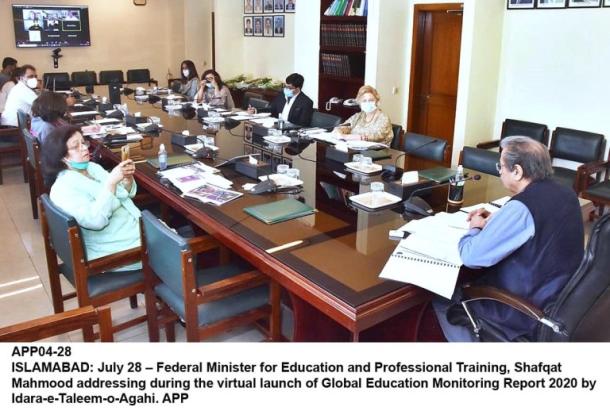
Idara-e-Taleem-o-Aagahi (ITA) organized and co-hosted the national virtual launch of the UNESCO’s 2020 GEM Report, calling all stakeholders to concentrate on those being left behind and move towards inclusion in education, particularly after COVID-19. GEM Report Senior Analyst Anna Cristina D'Addio gave a presentation on the 2020 GEM Report and shared the key findings from the report.
Federal Minister for Federal Education and Professional Training Shafqat Mahmood was the chief guest on the occasion. Launching the report, he said: "The online event featured an interactive high-level panel that discussed the key messages and recommendations in the report. “The GEM Report reminds us of the continued disparities in education, particularly in ensuring access of quality education to all, which is the foundation of inclusion,”
UNESCO Pakistan Country Representative Patricia McPhillips said: “ The GEM Report emphasizes the global need for better data collection and subsequent use,” she said, adding that it is encouraging to note that Pakistan’s inclusion-oriented data collection initiative is highlighted in the report as a best practice. Recognizing the Transgender Persons (Protection of Rights) Act 2018 and introduction of admission quotas to Disability Act 2014, she said that these are important milestones for ensuring inclusive education.
Speaking at the event, Department for International Development (DFID) Pakistan Country Director Annabel Gerry said , “T his report comes at a critical moment, where the coronavirus pandemic has added to the hidden emergency of exclusion from education. Since 2011, over 10 million children in primary school have benefited from UK support to Government of Pakistan’s education reforms, of which 4.7 million are girls. But significant inequalities remain by region, socio-economic status, disability, religion and gender. I hope this report will catalyze the will and resources to realize inclusive and equitable quality education in Pakistan. No country can ever reach its full potential unless every one of its citizens can reach their full potential. This is why we put inclusion at the heart of everything we do,” she said .
Other panelists included Planning Commission of Pakistan’s Member Social Sector Dr. Shabnum Sarfraz, Institute of Development and Economic Alternatives (IDEAS) Director and LUMS School of Education Interim Dean Dr. Faisal Bari and Special Talent Exchange Program (STEP) Executive Director Muhammad Atif Sheikh.
ITA CEO Baela Raza Jamil said, "There is much to do to set the actions right for Inclusive Education in Pakistan."
The report provides an in-depth analysis of key factors for the exclusion of learners in education systems worldwide including background, identity and ability and urges the countries to focus on those left behind as schools reopen so as to foster more resilient and equal societies."
Persistence of exclusion: The 2020 GEM Report notes that 258 million children and youth were entirely excluded from education, with poverty as the main obstacle to access. In Pakistan, hardly any poor rural women in Pakistan complete secondary school despite a target for universal secondary completion by 2030. Moreover, the gap in the probability of boys receiving more household resources for education was 13 percentage points for 5-9-year-olds and 24 points for 10-14-year-olds. Parents can thus help or hinder inclusion.
Inequitable foundations: The Profiles Enhancing Education Reviews (PEER) introduced by GEM Report show that many countries still practice education segregation, which reinforces stereotyping, discrimination and alienation. Education Acts for all four provinces in Pakistan mention children with disabilities/special needs and lay down mechanism for educating CWDs in separate schooling system based on the National Policy for Persons with Disabilities 2002. But education policies vary in emphasis on inclusion. In Punjab, under the 2012 inclusive education policy framework, students with mild and moderate disabilities are admitted to mainstream primary and lower secondary schools whose teachers are trained by master trainers of the Department of Special Education.
Blatant exclusion: The report states that fewer than 10% of countries have laws that help ensure full inclusion in education while exclusion can be very blatant in some laws. Although Article 16 of the Convention on the Elimination of All Forms of Discrimination Against Women prohibits forced and child marriage but girls can get married at age 16 in most provinces in Pakistan.
Alienating learners: The report further states that reflecting learners’ diverse needs require textbooks and curricula to be inclusive, yet many still alienate by omission or false representation – Girls and women only made up 24% of references in secondary school English-language textbooks in Punjab while women were represented in less prestigious occupations and as introverted and passive .
Chronic lack of quality data on those left behind: Pakistan is among the countries that do not collect data on disabilities in their Education Management Information System (EMIS). Household surveys are, however, the key to breaking education data down by individual characteristics. The Annual Status of Education Report (ASER) Pakistan survey, led by ITA, has included Washington Group’s Child Functioning Module to estimate the disability prevalence and educational status of children with disabilities in some regions of the country.
Signs of progress towards inclusion: The 2020 GEM Report notes that Pakistan is using positive, innovative approaches to transition to inclusion. The country is testing a ‘third gender’ option in data collection tools while Pakistan’s Transgender Persons (Protection of Rights) Act 2018 prohibits discrimination in education and establishes their right to education and a 3% quota for transgender children in mainstream public and private education institutions. Moreover, in 2019, Pakistan’s Government Rules and Disability Act 2014 introduced admission quotas for students with disabilities at all education levels. Tertiary education institutions were asked to exempt candidates with disabilities from admission tests, relax age limits, provide fee concessions, and offer appropriate examination modalities.
Media Coverage:
English Coverage:
https://www.dawn.com/news/1571663/conscious-effort-being-made-to-promote-inclusive-education-using-technology-minister
https://tribune.com.pk/epaper/news/Islamabad/2020-07-29/NmJjYmI4MjI5YWM3NWU0NzNiYmRmMzQ3OTkyMWJmYjQuanBlZw%3D%3D
https://www.brecorder.com/news/40008334
Photo Release:
https://www.app.com.pk/photos-section/photos-section/islamabad-july-28-%C2%96-federal-minister-for-education-and-professional-training-shafqat-mahmood-addressing-during-the-virtual-launch-of-global-education-monitoring-report-2020-by-idara-e-taleem-o/
Urdu Coverage:
https://www.express.pk/story/2063319/1/
https://twnews.co.uk/pk-news/nzm-t-lym-myn-ttykhnlwjy-khy-st-ml-khw-frwg-dy-rhy-hyn-wfqy-wzyr-t-lym
Related items
- Country page: Pakistan
- UNESCO Office in Islamabad
- SDG: SDG 4 - Ensure inclusive and equitable quality education and promote lifelong learning opportunities for all
This article is related to the United Nation’s Sustainable Development Goals .

Other recent articles


- Cover Stories
- Stocks Analysis
- PAGE Reports
Previous Editions
- Archive Articles 2023
- Archive Articles 2022
- Archive Articles 2021
- Archive Articles 2020
- Archive Articles 2019
- Archive Articles 2018

Education in Pakistan: problems, challenges and perspectives

Quaid-e-Azam Muhammad Ali Jinnah said and I quote:
“Education is a matter of life and death for Pakistan. The world is progressing so rapidly that without requisite advance in education, not only shall we lag behind others but maybe wiped out altogether.”
The education section of the executive summary of the Economic Survey of Pakistan 2021-22 notes: “Pakistan is committed to transform its education system into a high-quality global-market demand-driven system in accordance with Goal 4 of the Sustainable Development Goals (SDGs) .” However, the reality is vastly different.
The literacy rate in Pakistan in 2021 was only 62.8%. Any gains in literacy rates over the last many years have been small, slow and marginal.
In 2021-22, we spent only 1.77% of GDP on education-related expenditure at both the federal and provincial levels. Most UN agencies recommend that the minimum expenditure on education should be 4% of GDP. In recent years, the highest percentage of GDP we have spent on education was in 2017-18, when education expenditures were raised to 2.12%. The usual argument given for lack of spending on education has always been and still is that we do not have the resources.
In Pakistan, the current literacy rate is 62.3%. In Budget 1.7% of GDP has been allocated as Education Budget which is lowest in the region. The expenditure of Rs 74,609 billion has been allocated for Tertiary Education Affairs & Services in budget 2022-23; Rs 3,786 billion for pre-primary & primary education; Rs 8,863 billion for Secondary Education Affairs and Rs 2 billion for administration. Rs 44,174 billion has been earmarked for Higher Education Commission ( HEC ) under the Public Sector Development Program (PSDP) for the year 2022-23. (Business Recorder June 11, 2022).

According to data from the World Economic Forum’s Global Competitiveness Report 2017-18, the Global Competitiveness Index (GCI) shows Pakistan’s slow performance being ranked 129th of the 137 countries, on the Health and Primary Education related elements of competitiveness, when compared with other countries in the region like India, China, Bangladesh, Sri Lanka and Malaysia. The structure of school education system in the public sector is depicted in Fig. below.

Figure Above: The structure of school education system in Pakistan (Pre-Primary to Higher Secondary)
Education system creates sense of responsibility among people and they come to know the methods to achieve their national, societal and personal rights and it also enhances their general consciousness needed to deliver their duties as citizens towards their Nation. Once the realization originates, people start working for the development and prosperity of their motherland in the atmosphere of trust and co-operation.
The polarization and non – unified education system has resulted into outraged political turmoil, deadly terrorism, incessant sectorial violence, social disruption, economic instability and degeneration of government system. Whether it is poverty, non-availability of jobs, security uncertainty, sectarianism or terrorism, lack of tolerance, lack of general awareness, illiteracy, all are off shoots of the poor, inefficient and ineffective education system. The lowest budget allocation, a realm of large number of ineffective education policies has badly failed to take country out of economic, social, political and development quagmire.
Education has fundamental role in the economic, social, political and structural development of any nation. Many of the economic issues like poverty , overpopulation, unemployment , resource mobilization, inflation, exchange rate drastic fluctuation, housing, infrastructure, and health can be reduced and handled by improving education system in Pakistan. Education can also solve social issues like Baradari system, Wadera Culture, Chaudary regime and slave mentality. The political issues like battle for power by different politicians, lawlessness, fraud, corruption, religious riots, extremism, processions to gain popularity, use of indecent remarks, no public service, no human investment to save the lives of ignorant and deprived humans. Structural Development like transition from primitive methodologies to modern strategies; Shifts from Agriculture to Industry, hand made tools to mechanization, from physical conventional education system to Online Education and adoption of highly sophisticated and up to the mark technology can only happen with the strong Education Policy and implementation of country’s education system.
Pakistan, since its inception has failed to establish an education system which can fulfill the aspirations of the general public. Being a developing country, Pakistan is facing multifaceted problems and issues in the education sector. There are many issues prevalent and practiced in Pakistan’s Education System at all levels of Education – primary, secondary – colleges or universities.
The educational institutions within the country are divided into following categories: (1) Pre-primary School (2) Primary School (3) Middle School (4) High School (5) Higher Secondary (6) Inter-colleges (7) Degree Colleges (8) Universities (9) Non-formal Basic Education (10) Education foundations (11) Technical & Vocational Institutions (12) Teacher Training Institutions (13) Deeni Madaris
Pakistan’s schooling system consists of three main school types namely public sector schools, private sector schools and Deeni Madaris. These are further divided as public and private mainly due to curriculum and examination systems used in the schools and the language of instructions used by teachers.

The Broad Categories on education level are:
School Education (Pre-primary – Class 12) College Education (Degree Colleges Class 13-14) University Education
The education system of Pakistan is comprised of 305,763 institutions accommodating 51,186,560 9 students and 2,073,433 teachers. The system is composed of 189,748 (62%) public institutions and 116,015 (38%) private institutions, which also include 31,115 Deeni Madaris. The public sector is serving 28.49 million (56%) students to complete their education while the remaining 22.70 million (44%) are enrolled in the private sector of education. About 38 percent private educational institutions are facilitating 44 percent of students showing a slightly higher per-institution enrolment ratio in the private sector compared to the public sector.

There are a total of 186 universities & degree awarding institutions catering to the needs of higher degree students in both public and private sectors of education. Out of these universities, 111 (60%) are working under umbrella of public sector, whereas 75 (40%) are working in the private sector.

The total enrolment in the universities and degree awarding institutions is 1.576 million. Out of these 1.266 million (80%) students are enrolled in public sector whereas, 0.309 million (20%) students are studying in private universities and degree awarding institutions. In the overall national scenario only four percent students have access to university education. The total male enrolment in the universities is 0.881 million (56%), whereas, the female enrolment is 0.695 million (44%) . There are 56,885 teachers imparting higher education to the students in these universities. Universities in the public sector employ 38,011 (67%) teachers while those in the private sector have 18,874 (33%) teachers.
The significant issues of Education system are lack of Budget Allocation, lack of Policy Implementation, Faulty examination System, Poor Infra Structure of Educational Institutions, Lack of Teacher’s quality, low enrolment, Wayward and Directionless Education system, High scale drop outs, Increasing Political Interference, Out dated curriculum, corruption, Poor Management and Supervision, lack of Uniformity, lack of research, lack of faculty training and Development, Cost of Education, Terrorist Attacks, Cultural Constraints, lack of Parent input, Widening gap between Educational Institutions and Community, lack of Academia Industry Linkage program and Learning Crisis etc.
Education is the nurturing and nourishing force for the construction of strong and impressive societal set up, prominent development and significant growth of the country. Education explores new dimensions and polishes the hidden talent, potential, capabilities and strengths of individuals and redirect these forces towards the rise of Pakistan as a powerful nation on the global horizon.
Quaid-e-Azam Muhammad Ali Jinnah envisioned Education System of Pakistan as the driving force behind all the national goals. In the first National Education Conference held at Karachi. It was decided that Education System will work according to the National aspirations of Pakistan and it will be truly related to the needs of the people of Pakistan. The father of Nation said, “The magnificent goal of Education sector will be to develop character of Pakistan, high sense of responsibility, social integrity, selfless service to the Nation and morality on the part of the people of Pakistan.
Critical analysis of the problems and issues of education system in Pakistan.
These are the most dominant issues and problems of our Education System which needs to be addressed and to find remedial solutions for these issues and put forward recommendations for the positive change in our prevalent Education System.
1- Lack of uniformity
The Education System is not Uniform and is based on differentiated Education System like Public Institutions, Private Institutions and Deeni Madaris. There has been accelerated polarization in the Education System due to divisive Pakistani Education System. This has penetrated into cultural veins of the Nation. The recent waves of Sectarianism and Terrorism are the consequences of this divisible system. Polarized Education System has further divided society on political, economic and social grounds instead of uniting people. This division is leading towards further segregation on linguistic and religious levels and cutting knee deep the ideological foundation of the Nation.
2- Education without direction
A sound Education System is essential for every nation of the world. All nations develop their people or human resources on the basis of rigorous focus on Education and Training . We have poor and direction less education system with lack of cohesion and more prone towards general education without creation of Skillful man power resulting into massive unemployment. It also results into massive political, social, economic and cultural distress among people. There is no use of science and technology in the education system. Students are unable to develop critical thinking, creativity, imagination, reasoning, experimentation, innovation and invention
3- Outdated curriculum
We are still following the old fashioned and outdated Education System of rote memorization, cramming the facts and figures without realizing the holistic development of individuals. The objective of Education should be development of psychological, philosophical and sociological foundations of Education. The present curriculum is not motivating learners for practical research and development, scientific knowledge and reflective observation.
4- Lack of professional development of teachers
There are few training institutes but have lack of funds, lack of resourceful and trained trainers and administers. There are no defined standards of training and development. The courses and trainings are outdated, traditional without exposure to modern technology, motivation, quality of teachers and enhancement of skills .

5- Lack of quality teacher
According to UNESCO report, the quality of educational institutions and teacher is low. The situation is grimmer in remote parts of Punjab, Sindh, Balochistan where there is non availability of teachers. Teachers are not using new methods of teaching and learning, no lesson planning, old method of cramming, no research, no use of libraries or internet, no book reading. Students are promoted to next class on the basis of cramming and memorization of facts and figures without knowledge in depth, no conceptualization, no understanding of topics in the books without relevance in schools.
6- Alarming dropouts
Lack of management and discipline in schools leads many students to drop out from school. This trend is due to punishment in schools, poor parenting, lack of motivation, unattractive school environment, child labor & poverty are also very significant reasons of huge drop out from schools, colleges and universities. It shows that almost 30% of children enrolled in primary education. This trend has added to low literacy rate in Pakistan.
7- Examination system
Students are evaluated on the basis of annual exams, semester wise assessments. Both quantitative and qualitative exams should be introduced to judge the performance of students on comprehensive level and exams should evaluate the student’s ability through various types of reliable assessments like case studies, research papers, MCQs, Comprehensive subjective questions, Analytical questions to check the conceptual understanding of students especially in higher classes (Rehman, 2011).
In Pakistan examination system is faulty and it tests only the memory of students, there is use of unfair means, bribery, cheating, issuance of duplicate marks sheets, changes of marks, change of answer sheets, impersonation. This present examination system has promoted rote memorization and cramming. It has badly failed in producing critical thinking, analytical skills, learning, intellectual power and visionary reflection in the students at all levels of education. It does not measure the strength, achievements and performance of students (Quereshi, 1975).
Modular system of examination in Medical Universities is producing incompetent students with insufficient knowledge of Anatomy which is the backbone of medicine studies. In modular system a single paper for three subjects is given to students. Students prepare easy subjects to pass the exam and leave the difficult and important subject of Anatomy for choice. Therefore, this method has tarnished the strong foundations of learning and performing badly. Doctors produced with such type of examination with lack of proper understanding of subject will not be able to serve the humanity honestly and do the justice with their profession.
In our education system educational institutions are used as breeding grounds for political parties and in colleges and universities these groups nurture. Students get benefits by being part of any political party during exams. A list of students is provided to the teacher by the student leader to pass them in the exam, admissions are given on the party basis, exams are marked and checked on party basis because mostly teachers are also working for parties while sitting in educational institutions. During Board or University exam by giving money to the invigilator, students are allowed to cheat in the exam, Students throw question paper outside the window and one of the party rep climbs up the tree near the window with Megaphone and starts dictating answers by calling up question numbers. Honest Teachers are threatened and sometimes gunned and killed in case they are not willing to listen to the unfair demands of the students of different parties.
Some of the teachers are also involved in malpractices. They leak the paper by charging handsome amounts or solve the papers for students or allow students to solve the papers by cheating from books, material or from some good student. In board exams, before submission of sheets to the board office representative student is asked to write down correct answers. Teachers are themselves involved in such political activities and award “F” grade to students who are not in their party.
In Russia there is no exam system like ours. Students study through out the year and at the end of year teacher can ask any question from the book to pass the candidate and check his understanding & knowledge of the subject.
8- Poor supervision standards
To monitor teaching and learning, poor and harsh standards of evaluation and punishment are used which in some case leads to termination of jobs . At primary school level teacher’s evaluation is not possible. Secondary Schools/Cambridge Schools are evaluated through Board exam results/CAIE results. In college, again Board or University exam results are the criteria to judge the academic performance of Student and Teacher’s teaching. Whereas, actually there is an increase in tuitions instead of relying on School or College teaching. Students and their parents are compelled to go for tuitions due pressure of good grades and admissions in good educational institutions. There are many tuition centres, coaching centres, academies where the same teachers who were unable to impart quality education give quality tuitions by charging heavy amounts and prepare students well to score good grades. The low salaries demotivate them in their institutions to impart good education. In Universities students are given power to evaluate teaching and their grading becomes part of an Annual Evaluation Report which is essential for promotion or benefit of the faculty. This system is again polluted by involvement of computer department staff, Student coordinators and by bribing students to give bad remarks about any teacher. Some insincere and corrupt teachers mark students’ attendance and give them good marks, tell them questions of exams and do immoral activities to get good evaluation from students. Teachers who are honest and hard working are ranked low by students. Even at higher education institutions there is lobbying and politics through which false evaluation against any faculty can be prepared to get rid of the unwanted faculty by the management. So, in short, supervision system is more prone to harassment and control over the teaching staff rather than providing proper guideline and training for the improvement of teaching methodologies & strategies. (Rehman, 2011).
9- Internal and external influence
In Education sector external factors are coming outside the system through politicians and they bring changes in the system to give favor to their families, relatives, friends etc. Internal factors are bureaucratic manipulations (Mazhar, 2011).
There is great favoritism and Nepotism in cases of transfers, Appointments, Promotions, Salaries, Grades & Work Stations. Due to this the basic Infrastructure of the Education System in Pakistan has been badly affected (LOUIS, 1987).
10- Lack of resources
There are not proper Libraries with physical space for Students to Study. Books are not available, No digital libraries, no computer Facility in the library especially in public sector colleges & universities. No proper lighting, no AC, no Generators in case of power break down are available to make studies more comfortable for the desirous and ambitious students. Class rooms are over-crowded, corridors are flooded with students, Inadequate and Inefficient teachers, Laboratories without required apparatus & equipment of practical learning have resulted into a situation of despair and low standard of Education (Louis, 1987).
11- Lack of policy implementation
Frequent political turmoil and change of governments have made policy implementation in its true letter and spirit impossible. Corruption, Lack of Resources, Lack of teacher’s involvement in policies and inconsistency in successive planning on the part of various political regimes in Pakistan. Teachers are ignored while designing Education policies which has led to alienation between teachers and the system of Education (Zaki, 1989).
12- Low budgetary allocation for education
Education system in Pakistan has been crippled mainly due allocation of scarce financial resources in budget. The Education Budget which is definitely not sufficient to fulfill the growing needs of population and involvement of modern technology in the education system, low salaries, high taxation are also hindering the growth of this sector. Taxes are even imposed on the hourly payment of visiting faculty at the rate of ten percent from filers and twenty percent from non-filers which is really unjustified and reduces the meagre earning.
In many countries like Bangladesh & Sri Lanka the Education share in total budget of the country is increasing but in Pakistan it is continuously declining (Sayan, 2012).
13- Corruption
Corruption is another factor responsible for deterioration of the Education System, use of unfair means, nepotism, favors in transfer, promotion and appointments and decision making, misuse of funds, use of illegal authority by the school management, Gender based exploitation and harassment are the subsidiaries of corruption .
14- Lack of faculty training and development
Educational institutions do not spend available funds on the training and development of teachers. They are neither sent to attend the workshops, courses, seminars or conferences to groom themselves and learn the modern techniques and methodologies of teaching. Here again only few favorite teachers are selected for these trainings and most of the teachers remain deprived of any opportunity to groom their teaching skills.
15- Non- availability of public transport/ parking/traffic congestion
Most of the private schools are located in residential areas usually in bungalows to avoid taxes. Here the big issue is non-availability of public transport, parking and traffic congestion on daily basis. This makes both students and teachers tired and stressed because of wastage of lots of time of travelling to and from school to home. This unnecessary delay in timings also affects the quality of education. Mostly schools do not provide their conveyance to students, teachers and staff but ask them to avail transport of the companies with which the senior management set commission.
16- Opening up of large nuber of private schools
There is opening up of various private schools with a shift from Matric system to O & A level with Up-to-date modern technologies. They have comparatively better infrastructure, spacious class rooms, low strengths of class, more trained teachers, with proper sanitary conditions, counselors, doctors, psychologist, its teachers, sports teacher, swimming pools, etc. Creativity of students is enhanced through various activities. These facilities are missing in public schools so parents prefer to send their children to nearby private schools.
17- Politics in education
Different political parties prepare their representatives amongst students. Different teachers also involve them in this exercise as party members. These teacher in exchange of this get favors and benefits from parties by helping their students in getting admissions, provision of question papers, awarding of good grades as per list provided by the party.
18- Compulsion to purchase stationery, syllabus, uniforms and other items from school shop
School management compels parents to purchase the required stationery, syllabus, uniforms and all other required study material from their own school’s shop where the rates are too high as compared to the open market. This puts burden on the finances of the family and parents have to change the school or leave the school. The school charge fess for 3 moths and invest this amount in different profit schemes to earn interest on it.
During COVID-19 pandemic when due lock down schools were closed and even online classes were not in practice, school charged full fee from the students and parents had no option except listening to the management and doing as they demand to keep admission of their child locked and secured.
19- Entry tests, coaching and paper out
All the admissions have been linked with admission test in more or less all institutions making the credibility of different schools, boards, colleges and universities doubtful just to give benefits to the students who are non-deserving and not coming on merit with their results. Every year we hear about MCAT test, usually tests are postponed or test paper is out and re-exam is arranged and many of the students with good grades are pushed out of the admission list. The private colleges have their own test criteria and select students as per their own policies and even charge fees as per their own policies. Most of the deserving, hard working students due to the demand of heavy fees are forced to move towards some other institution. Every year PMDC is dissolved. For these entry tests students join academies, tuition centres and coaching centre and pay high charges to prepare for admission in all these high ranked Engineering and Medical institutes.
These admission tests are introduced to favor their own families, relatives, friends or workers of the political parties to strengthen their vote bank in their constituency.
These tests are fake, their results are fake, the merit lists displayed are fake. In this way many deserving students do not get chance to pursue education of their own choice.
20- Theoretical knowledge inplace of practical learning
Students are given only bookish theoretical knowledge instead of practical knowledge. Most of the students even after getting degrees do not meet the requirement of jobs and are unable to be absorbed in the working population. Students should be sent at least for one semester in organizations before their graduation so that they may become acquainted with the office environment and familiar with the working of different reputable organizations. Activities, Role plays, Case Studies, Worksheets, Research Projects, Seminars, Symposiums, Lecture Series, Events should be organized for the students with their hundred percent involvement so the students not only own the activity but get an opportunity to meet influential people from big companies of reputable brands.
21- Lack of liaison between industry and educational institutions
Mostly universities have no liaison with industries and therefore their students face problems at the time of induction. Universities should invite industrialists to teach courses especially in the last two semester of their studies so that students can learn about the ins and outs of the industrial workings and may get a chance of absorption in the industry as employees.
22- Non-participatory in nation building
Education Sector is not playing any role in Nation Building. Our Education System is producing students with mindset that only foreign countries are providing good education and to get good job it is necessary to become foreign graduates. Mostly Students lack patriotism, civic sense, loyalty and love for their homeland and people living here and treat them as inferior to the foreign world. So being Status conscious and due ostentatious effect our crème has moved abroad for higher education. On the other hand, students who get them enrolled here in Pakistan after getting degrees and job search find it best to move abroad for higher studies, job and career growth. Once they get job, they prefer to stay there on permanent basis and become citizens of that country with dual nationality status. Our best youth has settled in European Countries, USA, UK, Canada, Germany, Spain, Italy, Australia, Malaysia, South Africa and Gulf Region and rendering their best services and earning handsome salaries and maintaining luxury life styles in those countries without any fear of security, terrorist attacks, bomb blasts, sectarian riots, traffic congestions, pollution, Smog, energy Shortage etc. By being there they feel satisfied and happy. They do not send any remittances here instead they are calling up their families, relatives and friends to come and transfer their assets to those countries making Pakistan’s economy weaker with this outflow of resources. Our Doctors, Engineers, Architects, Retired Army Officers, Bankers, health workers paramedical staff, skilled labor, business graduates, pilots, Air men, Air Technicians, Aircraft Engineers, Educationists, Insurance Agents, Scientists and Researcher have moved to Western countries and are not willing to come back or serve the Nation.
23- Pupil teacher, pupil school and teacher school ratio
These ratios are very important. If there are more peoples in one class then teacher cannot give individual attention to students. Weak students are neglected and gap between strong and weak students widens. If pupil school ratio increases then infrastructure does not accommodate the increased number of students and in place of two students, three or four students are asked to sit. Other facilities like availability of labs, computers, access to canteens, sports items, playgrounds, washrooms etc. become less for the large number of people. If schools have low number of teachers hirings then work load for one teacher is overburdened and individual attention, mood, behavior, marking of copies/assignments or imparting of quality education is disturbed. The ideal class size is 30 students at most for one teacher but in our universities sometimes more than 100 students are accommodated in one class.
24- Non-availability of electricity
Load shedding and energy crisis in the country has devastatingly ruined the quality of education. In summer when the weather is hot and humid, then in the class of 68-70 students when teacher has very limited space to move, then there is suffocation, lack of oxygen, smell of sweat and loss of student’s attention in studies. This is a source of big demotivation for students and teachers and they want to leave.
25- Non-availability of drinking and washing water in toilets
In most of the schools clean drinking water is not available. Mostly the washrooms are not cleaned on regular basis so health hazards are faced by the students and teachers especially female students suffer a lot because of this. Mostly, schools’ students suffer from cholera, diarrhea, typhoid etc.
26- Non-availability of boundary wall
There are many schools in villages, towns and even cities where schools are working without boundary walls, which has become a security hazard.
27- Terrorist attacks and child killing
Terrorist attacks in schools like APS, Peshawar where a large number of students were killed. Schools are force to provide security to students. Attacks on students, teachers, on school buses, entrance of school buildings have decreased enrollment in schools.
28- Female students and female teachers’ harassment
Female students and female teachers are sexually harassed by male teachers. Many students are threatened not to speak against the culprit. In universities many male teachers award good grades to female students after their sexual assault. In jobs, females involved in such type of illicit activities and involved with the management get all kind of benefits of increments; increase in salaries, courses abroad, promotions and in some cases female faculty was awarded PhD degrees even when their research work was not up to the mark and rejected by external supervisors.
29- Parent’s input for improvement of education system at all levels
Parents should be involved at all education levels to maintain the high standards of education and learning.
30- Cost of education
The economic cost is higher in private schools and they are located in rich localities only though they provide better quality of education. Public schools ensure equitable access but low-quality education.
31- Cultural constraints and traditional taboos
Due to cultural constraints and traditional taboos parents prefer early marriages of their girls instead of sending them to schools. Similarly, mothers feel comfortable when girls stay home and help mothers in baby sitting and finishing household chores. In some of the areas only boys are sent to schools considering them as head of the future families and girls are asked to learn some family skills like embroidery, weaving, pottery or for cattle care.
32- Illiteracy of parents and parental concerns
Due to non – availability of Education and lack of awareness poor parents have number of children in the hope that they will become their earning hands and instead of sending them to school their mothers working in different houses as domestic help take them along for the baby sitting of the children of theses houses and demand money for that. They think that investing girls will be of benefit to the in laws or her husband since they will not get any return from it so its better as long as girls are staying in their homes they should earn and bring money for the family.
33- Learning crisis:
The education system is not producing students who are learning from education as per the requirement of the standard in which they are studying. Maybe a student studying in class five does have the knowledge of class two or three only. This Learning Crisis has become the biggest issue of our current education system. It means there is wide gap between school input and school output.
34- Distance:
There are many schools which are far from some of villages and there are no means of transportation and children have to walk on foot to reach schools miles away from their homes which is not possible for girl students to do as parents do not want to send their girls unattended and do not accompany them since they have to work to meet both ends.
Recommendations:
- Budget allocation should be increased as per international standards of education.
- Schools should be shifted on solar system to handle the issue of load shedding.
- Pupil teacher, pupil school and teacher school ratios should be balanced and class strength, teacher’s number and number of classrooms should be in accordance to the international education standards.
- Boundary walls should be made. Security staff should be hired, CCTV cameras should be installed, student teacher and staff should be issued identity cards.
- For teacher training and development quality professional institutes with sufficient funds should be set up.
- Political and bureaucratic influence should be minimized at all educational levels.
- The system of accountability should be strengthened and all associated in education system are trained to own responsibilities both at individual and collective basis.
- Curriculum should be revised on annual basis and new strategies and methods should be incorporated to align our education system with other countries.
- Examination system should be made free of unfair means, Mafia culture and illegal gratification. Supervision and monitoring should be strong to subside this element.
- Policies should be implemented with delay and in continuity to get their outcomes.
- The culture of research should be promoted in the educational institutions.
- There should be Academia industrial linkage programs to make our education practical and our students capable of absorption in the job market.
- Introduction of technical and vocational trainings at secondary schools.
- Increasing public expenditure on education and skill generation from 2.7% of GDP to 5% of GDP and then to 7% of GDP.
- Reduce polarization and try to introduce uniform standards at all types of schools.
- Enhance the scale and quality of education in general and the scale and quality of scientific/technical education in Pakistan in particular.
Conclusion:
Sense education is developing not only mind but it also cleans and grooms our body and soul. We not only get education for economic reason but to handle social, political, psychological, ethical, legal and spiritual issues of our life. Education turns a raw human into a polished human being which becomes human capital of any nation and key to the development of that country. With education many countries are ruling the world and have become leaders in the comity of nations. The current system has made our younger generation direction directionless and uncertain about their future so they are leaving Pakistan and settling down in developed countries. The lawlessness, fear of loss of life, terrorist attacks, unemployment, inflation, exchange rate fluctuation, overpopulation, poverty, taxes and IMF loans are producing forces of degree holders without any vision, mission, critical thinking, reflection, analysis, research and creativity. Our outdated curriculum is pushing our youth towards stone age instead of directing them towards the fast-changing technology driven world. Traditional teaching is giving theoretical knowledge to students but practical learning is missing.
Finally, education reforms are the only solution to change the existing education system so following recommendations are suggested for the policy makers, thinkers, researchers, educationists and common people. Hope it will add value in the research and development of both student and teachers.
References:
- http://library.aepam.edu.pk/Books/Pakistan%20Education%20Statistics%202017-18.pdf
- https://files.eric.ed.gov/fulltext/ED570671.pdf
- https://contentgenerate.com/problems-of-education-sector-solutions-pakistan-content-generate/
- https://www.finance.gov.pk/survey/chapter_22/PES10-EDUCATION.pdf
- https://ipripak.org/education-system-of-pakistan-issues-problems-and-solutions/
- https://www.morenews.pk/real-issues-education-system-pakistan/
- Zaki W. M., “Evaluation of Education Plans and Projects”, Islamabad, National Book Foundation, 1989.
- Save the Children & UNICEF “Disciplining The Child Practices and Impacts”, NWFP: School & Lietarcy Department, 2005.
- Rehman H. and Khan N., “The flaws in Pakistan’s Education System”, Abasyn Journal of Social Sciences, vol/issue: 4(1), 2011.
- Louis D. H., “The crises of Education in Pakistan”, Lahore, Vanguard Book Ltd., 1987.
- Iqbal M., “Education in Pakistan”, Lahore, Aziz publishers, 1981.
- Qurashi I. H., “Education in Pakistan”, Karachi, Ma,aref LTD, 1975.
- Sayan, Fida, and Hussain, “Pakistan existing education system”, 2008. Retrieved from Retrieved from www.eric.articles/pak/edu on dated 2012, July 18.
- Naseem J. Q., “Problem of Education in Pakistan”, Karachi, Royal Book Company, 1990.
- Government of Pakistan, Ministry of Education. “National Assessment Findings”, Islamabad, National Education System, 2006.
- Ahmed, Iqbal.,” Critical Analysis of the Problems of Education in Pakistan: Possible Solutions”, . International Journal of Evaluation and Research in Education (IJERE) Vol.3, No.2, June 2014, pp. 79~84 ISSN: 2252-8822.
Type above and press Enter to search. Press Esc to cancel.

- High contrast
- Work with us
- Press Centre
Search UNICEF
The digital transformation of public education in pakistan, unicef's learning passport programme empowers students.

Karachi, Sindh: In a country like Pakistan, where a significant gap exists between technology's potential to revolutionise the education system and its current state, UNICEF introduced the Learning Passport (LP) programme. The objective was to address considerable equity challenges, especially for marginalised children, particularly girls, through access to digital learning.
The LP programme, a solution designed by UNICEF with Microsoft to close the learning poverty gap, is a digital platform enabling high-quality, flexible learning. In Sindh, this was piloted as an 'education model' for middle school girls and boys (in grades 6-8), making digital content aligned to the Sindh Government curriculum available through the platform to ensure their education meets specific learning standards. The LP stores each student’s unique learning history allowing targeted support to improve their learning experiences.
At the Government Girls Comprehensive High School (GGHS) in North Nazimabad, Karachi, the LP programme demonstrated its effectiveness. “We have found it to be very effective for our girls,” expresses Dr. Shazia Syed, GGHS Principal, enthusiastically, noting its high impact on students' eagerness to attend LP classes.
The programme enables students to strengthen their academic experience by helping to bridge the digital learning divide. In Pakistan, inequitable access to EdTech (educational technology) for learners is influenced by geographic location, the educational institution they attend, and the grade level they are in. With only 33% of households having internet access, many students encounter challenges using learning solutions, especially girls.

Its unique interoperability feature enables access to educational applications in local languages, ensuring inclusivity and catering to the diverse linguistic needs of students. By using digital tablets, the programme introduces a system of learning that is not bound by traditional classroom constraints. With 90% of its current users being girls, the LP prioritizes narrowing the digital gender divide while enhancing learning outcomes.
The pilot initially focused on three pivotal subjects where most students were seen struggling: Science, Social Studies, and Mathematics, with digital content developed based on the Sindh Education Curriculum and endorsed by the Sindh Education & Learning Department.
Since its inception in September 2022, the LP pilot programme has made significant strides, engaging over 4,000 students across 28 schools in Karachi, Hyderabad, Jamshoro, and Sukkur. With 970 tablets distributed among participating schools and designated classrooms dedicated to Learning Passport sessions, the infrastructure is well-equipped to support the programme's objectives. This becomes particularly important for schools without conventional computer labs due to cost constraints or inadequate internet access, or those with obsolete computer equipment.

In supervised sessions, students access digital content aligned with their subject curriculum using tablets. Scheduled Learning Passport classes cover each subject weekly. Guided by teachers, students navigate through instructional videos, interactive games, and assessments upon completing modules. These built-in tools, like online questionnaires and quizzes, help evaluate student performance, aiding teachers in tracking progress and finding ways to support students’ academic growth.
Muniba Khan, a dedicated math teacher at GGHS, emphasizes the programme's positive impact. "It's easier for me to teach because the girls’ concepts are now clearer. They can watch the video at their own pace and rewatch or ask if something is unclear," she says.
Beyond its structured curriculum, the Learning Passport programme excels in breaking down complex learning objectives into comprehensible components through its diverse range of multimedia resources. The LP’s approach not only encourages peer-to-peer learning but also empowers students to learn at their own pace, promoting a sense of autonomy and self-directed learning.

Students like Kashaf, aged 13, exemplify the programme's success stories. Kashaf speaks of her experience, stating, "Tablets teach us through multimedia presentations. We enjoy the videos and the games, and it helps make concepts clearer for us."
She appreciates the program's flexibility, finding it more engaging than traditional chalkboard lessons. Pausing videos and seeking immediate clarification has enhanced her learning.
The Learning Passport programme extends beyond classroom boundaries, enabling students with internet connectivity to access learning materials at home. This not only fosters independent study but also aids UNICEF in measuring learning outcomes through assessment records.
GGHS teachers are thrilled with the pilot program's integration into the curriculum, witnessing its positive impact on student learning. They are eager for its continuity and propose adding English, aligning with student and parent desires for expanded opportunities and an enriched educational experience.

Lessons learnt from the Learning Passport pilot include the creation of a training programme for lead trainers who can offer continuous support to public school teachers, including a digital certification for deploying the LP and the provision of support channels for teachers using WhatsApp or email.
It is evident that this initiative serves as a beacon of hope in narrowing the digital gender divide. Its success calls for broader adoption and increased funding to expand its reach beyond Sindh, envisioning a future where such innovative educational programmes uplift public schools across Pakistan.
Related topics
More to explore, bridging the learning gap in punjab.
Global Partnership for Education and UNICEF provide out-of-school children in Punjab, a second chance to learn.
“We want education, and we need it the most.”
Accelerated Learning Programme rekindles hope for out-of-school girls to continue learning in flood affected districts of Punjab
Transitional School Structures provide conducive learning
UNICEF and GPE help School Education Department enroll and retain students in the aftermath of floods
Breaking barriers through education
Education centres supported by the Global Partnership for Education are helping children learn for the very first time in Khyber Pakhtunkhwa
Brought to you by:

Primary Education in Pakistan: Show Me the Evidence
By: Anjani Datla, Asim Khwaja
This case has two parts, a text-based case and a supplemental PowerPoint presentation. The case traces the evolution of an evidence-based research study on the education sector in Pakistan. In 2003,…
- Length: 5 page(s)
- Publication Date: Apr 30, 2014
- Discipline: Business & Government Relations
- Product #: HKS772-PDF-ENG
What's included:
- Teaching Note
- Educator Copy
- Supplements
$4.95 per student
degree granting course
$8.95 per student
non-degree granting course
Get access to this material, plus much more with a free Educator Account:
- Access to world-famous HBS cases
- Up to 60% off materials for your students
- Resources for teaching online
- Tips and reviews from other Educators
Already registered? Sign in
- Student Registration
- Non-Academic Registration
- Included Materials
This case has two parts, a text-based case and a supplemental PowerPoint presentation. The case traces the evolution of an evidence-based research study on the education sector in Pakistan. In 2003, Atish (fictionalized character), a Pakistan-born, Harvard educated economist returns to his native Pakistan to help reform a lagging education system. But Atish unearths conflicting information on the state of education in his country. Despite large investments, government-run schools are failing to provide quality education. And international media coverage asserts that the educational void in Pakistan is rapidly being filled by madrassas, or religious schools, that are designed to train children in extremism. Upon closer scrutiny, Atish finds holes in the madrassa enrollment numbers. Similarly, Atish learns that affordable private schools have sprung up across the country, yet no nationwide analysis on the quality of education they provide exists. In rural Pakistan, he also learns to suspect conventional wisdom regarding parental involvement and interest in educating their children. Before he can develop policy recommendations, Atish will have to separate fact from anecdotal information to understand the education landscape in Pakistan. Case number 2003.0
Learning Objectives
Using sound empirical data is crucial to developing effective policy. Atish's experience in Pakistan brings to the forefront the importance of seeking and using valid data as the building blocks of evidence-based policy. The case enables students to understand key factors of high-quality data such as reliability, validity and measurability and teaches them to apply an analytical framework when trying to influence policy spheres.
Apr 30, 2014
Discipline:
Business & Government Relations
Geographies:
Harvard Kennedy School
HKS772-PDF-ENG
We use cookies to understand how you use our site and to improve your experience, including personalizing content. Learn More . By continuing to use our site, you accept our use of cookies and revised Privacy Policy .

IMAGES
VIDEO
COMMENTS
Presentation Transcript. EDUCATION System in Pakistan 5 December , 2008 1. Contents PART - I • Constitution of Pakistan • Organization & Functions PART - II • Education Scenario • Financing • Education Policy • Other Programmes 2. Constitution of Pakistan 3. Constitution of the Islamic Republic of Pakistan, 1973 - Article 37-b ...
Pakistan Education Statistics 2021-22 - Highlights Report6 There are 26.2 million out of school children in Pakistan in 2021-22. 11.73 million, 7.63 million, 3.63 million, 3.13 million and 0.08 million students are out of school in Punjab, Sindh, KPK, Balochistan and ICT respectively. In terms of percentage out of school children, 39% of ...
almost every walk of life. Education is now recognized to be the only key to moral, cultural and socio-economic development in any country around the world. The need for innovative approaches and use of e-system in education is increasingly felt in the tasks of educational development. Pakistan is one of the populous countries.
Presentation Transcript. EDUCATION System in Pakistan 1. Constitution of Pakistan 2. Constitution of the Islamic Republic of Pakistan, 1973 - Article 37-b "The State shall remove illiteracy and provide free and compulsory secondary education within minimum possible period" Concurrent Legislative List: Curriculum, syllabus, planning ...
education, economic development, educational reform, Pakistan. Corresponding author: David E. Bloom Department of Global Health and Population Harvard School of Public Health 665 Huntington Avenue Building I 12th Floor, Suite 1202 Boston, MA 02115 USA E-mail: [email protected]. Pakistan's education system faces many well-known problems.
Stages of formal education Primary education A primary school in a village in the Sindh region. Only about 67.5% of Pakistani children finish primary school education. The standard national system of education is mainly inspired from the English educational system. Pre-school education is designed for 3-5 years old and usually consists of three stages: Play Group, Nursery and Kindergarten ...
Abstract. In Pakistan, all children between 5 and 16 years of age have the right to 12 years of school education. The public school system is the main provider of schooling. Pakistan takes explicit account of gender in the provision of schooling, especially in public schools at post-primary levels, with girls' schools with female teachers and ...
An encouraging increase in education budgets has been observed though at 2.8 percent of the total GDP, it is still well short of the 4 percent target. Young girls and boys attend their class in UNICEF supported Government primary school Kalpani dagger, Buner district Khyber Pakhtunkhwa province of Pakistan.
Education System in Pakistan thIn Pakistan, education is now a provincial subject as a result of the 18 Constitutional Amendment legislated by the parliament during April 2010. ... These assessments and progress reports were basically meant for presentation in the regional and international forums, but were also used internally to revisit ...
Signs of progress towards inclusion: The 2020 GEM Report notes that Pakistan is using positive, innovative approaches to transition to inclusion. The country is testing a 'third gender' option in data collection tools while Pakistan's Transgender Persons (Protection of Rights) Act 2018 prohibits discrimination in education and establishes ...
The education section of the executive summary of the Economic Survey of Pakistan 2021-22 notes: "Pakistan is committed to transform its education system into a high-quality global-market demand-driven system in accordance with Goal 4 of the Sustainable Development Goals (SDGs)." However, the reality is vastly different.
22 December 2023. Karachi, Sindh: In a country like Pakistan, where a significant gap exists between technology's potential to revolutionise the education system and its current state, UNICEF introduced the Learning Passport (LP) programme. The objective was to address considerable equity challenges, especially for marginalised children ...
Educational Policy of 1972- National educational policy of 1972 was introduced under the supervision of Zulfikar Ali Bhutto on March 29, 1972. The policy mainly incorporated the ideology of Pakistan, equal free and universal education for both male and female up to 10th class.
This case has two parts, a text-based case and a supplemental PowerPoint presentation. The case traces the evolution of an evidence-based research study on the education sector in Pakistan. In 2003, Atish (fictionalized character), a Pakistan-born, Harvard educated economist returns to his native Pakistan to help reform a lagging education system. But Atish unearths conflicting information on ...
1 INTRODUCTION. Despite sweeping promises by a succession of governments to improve Pakistan's education system (Khalid & Khan, 2006), more than 60 years on Pakistan still possesses a dilapidated education system (Ali, Hakim, & Abdullah, 2017).This is an education system, which is rife with corruption, lacks a national curriculum or qualified teachers, and fails to produce any international ...
C.J. Dubash believes that Pakistan needs to make some strategic policy level reforms to revamp its outdated and broken education system. Over the last decade, there has been a tremendous rise in ...